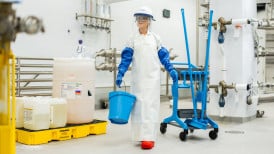Safety & Personnel

- July 11, 2012
We all understand risk. We take a risk each day we get into the driver’s seat of our car. We take a risk when we start up the mower to cut the grass. However, we fasten our safety belt and put the phone down when we get into the car; we wear durable shoes and eye protection when we mow. This allows one to, at least, help minimize the risk involved. The same reality exists in the food and dairy industry workplace, and a key to preventing employee injury in these facilities is to have a standardized lock-out/tag-out program.
“Lock-out” and “Tag-Out” (LOTO) programs, for those that may not know, are programs to prevent unexpected startups of machinery and/or the release of hazardous energies during day-to-day operations and maintenance. This is done with easy-to-see locks and/or tags that prevent the use of specific machines and operations. The simple ability to alert all personnel to work being done and to indicate parts of an operation that need to remain untouched is cited as preventing “an estimated 120 fatalities and 50,000 injuries each year”.
One only has to do a quick search in general news and trade publications to see that the system is far from universally implemented. Companies continue to draw undesirable headlines discussing steep fines, safety violations, and the loss of life and limb for workers in these environments. Some of these headlines are due to outright negligence; they can also be the result of a lack of proper awareness and training.
- June 26, 2012
As an NJ customer, do you find yourself only in one or two sections of the catalog, or always hitting the same tab on the website? In the forthcoming weeks, some of
- June 13, 2012
This is the final article in a series of three articles focusing on 5S methods.
In this third of three pieces on the 5S program (you can learn more about 5S and associated products by clicking here or here.
5S is a method developed to create standardized, efficient, clean, and safe working environments. A common way of implementing 5S methods in facility is through the use of color-coding. An effective color-coding system in a kitchen, factory, processing facility, hospital, etc. does a lot to help meet the “standardizing," and "sustaining"
- June 08, 2012
This is the second article in a series of three articles focusing on 5S methods.
In last week's article, we took a brief look into the 5S method. This step-by-step method of workplace organization has been successfully incorporated into an array of settings: from industrial work floors to governmental offices. In this second of three pieces examining 5S, we’ll focus on a relatively simple but extremely effective product that
- January 12, 2012
Handwashing is a front line of defense when it comes to food safety. It is also a commonly misunderstood practice that deserves some careful attention, as seemingly self-apparent as it might appear.
The Mayo Clinic states that “frequent hand-washing is one of the best ways to avoid getting sick and spreading illness,” and “offers great rewards in terms of preventing illness. Adopting this simple habit can play a major role in protecting your health.” In the food industry, proper handwashing is a practice that can keep both your customers and your employees safe and healthy. For many folks, there are many misconceptions about handwashing that are out there because of its supposedly obvious nature. The Center for Disease Control recommends the following as standard protocol.
See how this compares to your ideas about proper handwashing:
• Wet your hands with clean, running water (warm or cold) and apply soap.
• Rub your hands together to make a lather and scrub them well; be sure to scrub the backs of your hands, between your fingers, and under your nails.
• Continue rubbing your hands for at least 20 seconds. Need a timer? Hum the "Happy Birthday" song from beginning to end twice.
• Rinse your hands well under running water.
• Dry your hands using a clean towel or air dry them.Though it may be strange for visitors to your operation to hear employees humming “Happy Birthday” throughout the facility, consider it the sound of properly ensuring enough time to effectively combat germs and thus, avoid contamination of the final product.
- November 14, 2011
Originally from the Japanese car industry, the 5S method is now commonplace in production facilities globally. It provides a streamlined work environment that can lower costs, increase efficiency, and produce better product and a more motivated staff. 5S lays the groundwork for a visual workplace – for improving quality, organization, efficiency, housekeeping AND safety in your organization.
5S consists of these components:
Sort – go thru each area and eliminate all tools and supplies not used in that process.
Set in Order - arrange the work area for maximum efficiency, everything in its place.
Shine - a systematic approach to cleaning and scheduled maintenance of all equipment.
Standardizing - everything looks the same and is simplified.
Sustaining – keeping up what has been accomplished.
- December 30, 2010
Metal detection is an important part of food processing efforts to ensure food safety and more. According to an August Cheese Market News piece: “preventing






